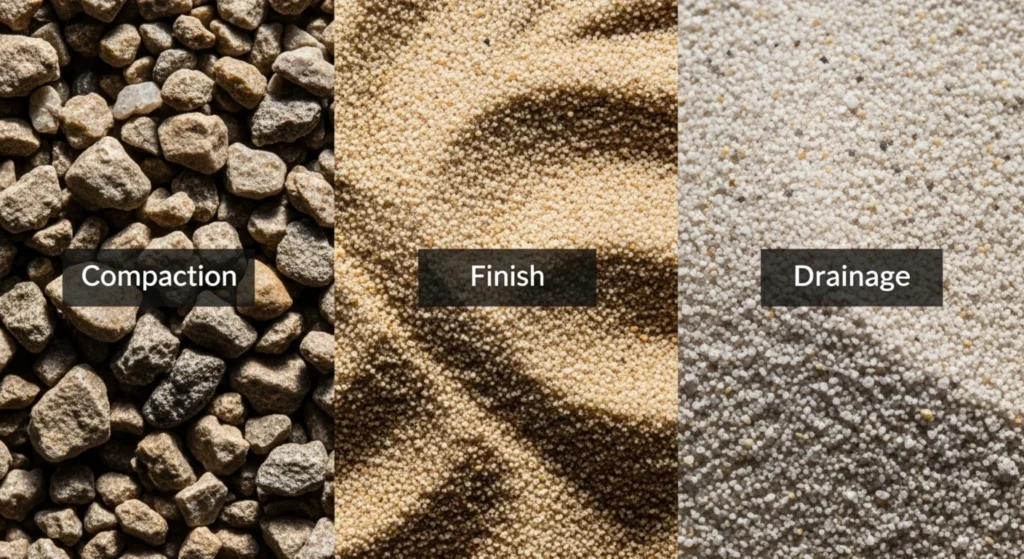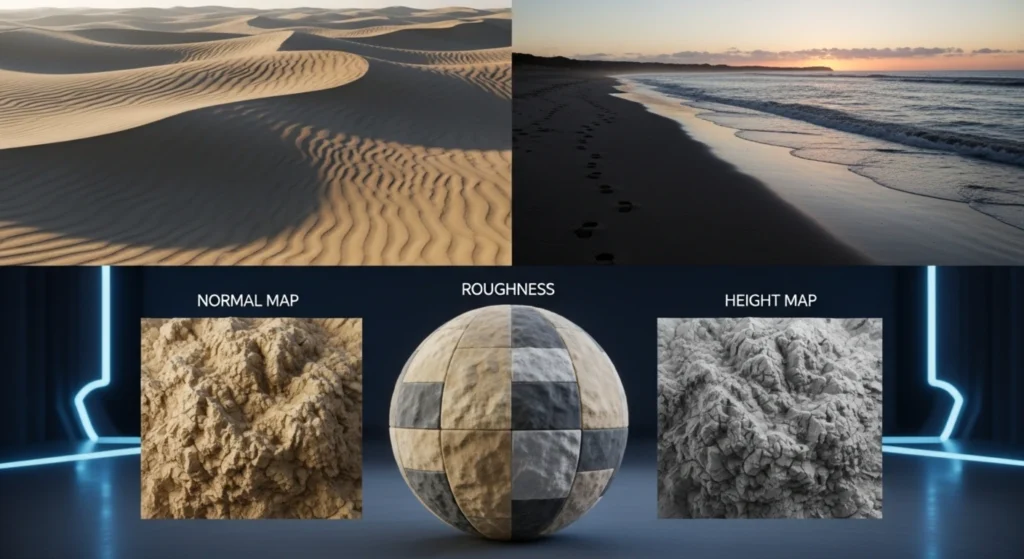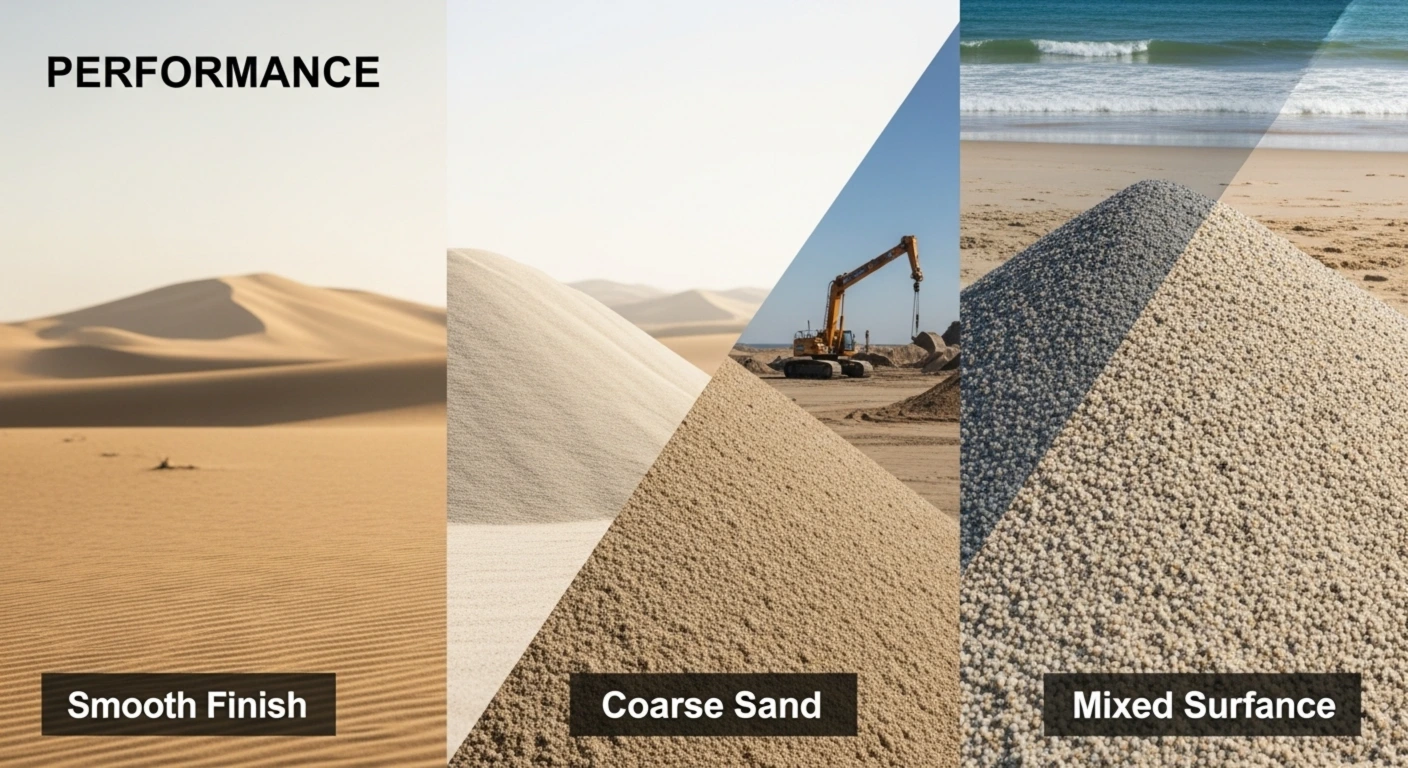Sand texture decides how a surface looks, drains, compacts, and wears over time, so choosing the right texture is key for pavers, paths, beds, mortar, stucco, and even digital PBR materials for 3D design. Sand texture also has a precise meaning in manufacturing where surface roughness values like Ra control coating grip and part performance. This complete guide explains what sand texture is, how to select the right type for the job, and how to install and maintain it so projects last and look great.
Sand texture also matters in digital work because tileable PBR sand materials rely on correct normal, roughness, and height maps to render believable dunes, beaches, and paths without repeating patterns. Whether building a patio, improving soil structure, finishing concrete, or authoring game-ready materials, a clear plan for texture will save time and money and improve results.
Sand Texture Basics and Why It Matters
Sand texture comes from grain size, shape, and mineral mix, which together impact compaction, drainage, load transfer, and the final look of a surface. Coarse, angular sand interlocks and drains fast, making it ideal under pavers and as a base layer for stable hardscapes. Finer, more uniform sand feels smoother, sets tight finishes, and works in play areas and mortar but needs proper containment to prevent washout or drift.
In soil science, sand texture boosts aeration and reduces waterlogging, but it also lowers water and nutrient holding, so balance it with organic matter for healthy beds. In construction and mixes, sand quality affects strength, bonding, workability, and permeability, so cleanliness and grading are important to the finished product. For visual design, color variation like white, beige, yellow, or red brown helps set mood and brightness and changes how large or open a space appears.
Sand Texture for Landscaping and Hardscape Stability
Landscaping needs sand texture matched to use and loads, since the wrong texture causes shifting, rutting, or pooling across seasons. Concrete sand and masonry sand are common choices where compaction and drainage are both required, since their grading supports bedding and joint performance under pavers and slabs. Utility or fill sand is coarse and works as a foundation layer, especially with geotextile over weak soils and proper base aggregate below the bedding layer.

In arid or minimalist designs, sand as surface mulch tightens lines, manages weeds, and encourages quick surface drying after rain while still allowing infiltration. For clay-heavy sites, sand blended with compost improves structure for roots and reduces compaction, though avoid adding only sand without organics, which can create dense layers that hinder roots. For borders, paths, and play zones, choose texture based on foot traffic, wind, and slope, then lock edges with metal or stone to reduce migration and ongoing cleanup.
Types of Sand and How Texture Affects Performance
Each common sand type carries a texture profile that changes how it compacts, drains, and looks once installed, so choose by job rather than by price alone.
- Concrete sand
Coarser grading with angular grains that compact well, support paver loads, and drain fast, often used in mixes, bedding layers, and as part of base systems under patios and walkways.1] - Masonry sand
Finer, more uniform texture for mortar and tight finishes and often used where smoother joints or surface appearance matters across patios and decorative fields. - Utility or fill sand
Coarse and mixed texture used as general fill and base material where compaction and simple grading matter more than finish appearance. - Play or white sand
Fine, clean, and soft for play zones and bright landscape accents or top dressing where skin comfort and visual brightness are key considerations.
In mixes and mortar, sand cleanliness and grading have direct effects on bond and strength, so source from reliable suppliers and verify use case alignment with the chosen sand type. For decorative impact, lighter sands increase brightness and perceived size of small spaces, while darker sands add contrast around pale stone or lush plantings.
Drainage, Soil Structure, and Water Management with Sand
Coarse sand texture improves infiltration, protects paver systems from pooling, and supports bed aeration and root health when blended thoughtfully in soil. In French drains, under slabs, and along foundations, sand layers with proper gradation help move water away while filtering debris that might clog systems downstream. In rain gardens and bioswales, sand helps manage stormwater and supports microbe communities that improve water quality before release or infiltration.
For plant beds and pots, a sand addition helps prevent root rot by moving excess water out of the root zone while improving gas exchange, but monitor irrigation to offset lower water retention in sandy mixes. Where clay dominates, blend sand with compost so beds hold enough moisture while avoiding hardpan that comes from adding sand alone without organic structure. In hot, dry climates, pair sand with mulch or fine gravel to slow surface evaporation while protecting soil biology under the top layer

Manufacturing Meaning of Texture and Ra for Coating and Finish
In manufacturing and coatings, texture is the measurable roughness and lay of a surface and it decides how well paint, sealers, or adhesives stick and how parts wear in service. The common metric is Ra, which averages how far points on a surface deviate in height from the mean line across a measured length, giving a simple indicator of overall roughness level. A typical as-machined baseline is about 3.2 micrometers Ra for many parts and processes, with lower Ra for smoother finishes and higher Ra for more grip or functional texture when needed.
Rz complements Ra by showing the average distance between the highest peaks and lowest valleys across selected segments, which helps when peak height matters for sealing or sliding behavior. Selecting the right target values helps balance coating adhesion, friction, wear, and cost, since extra polishing adds time without always improving performance in service. For field prep and shop finishing, controlled texture improves primer key and reduces failures caused by overly smooth or contaminated surfaces before coating
Digital Sand Textures for 3D, PBR, and Visualization
Digital sand textures use physically based rendering maps like albedo, normal, roughness, reflection, and height to capture correct light response across wet, dry, and rippled sand states. Tileable PBR sand assets reduce repeating patterns while keeping scale correct, so footsteps, ripple spacing, and grain detail match real scenes at typical camera distances. For large environments, blend multiple sand materials and add height variation or parallax to break up repetition and maintain realism in shallow angles and long shots.
Asset libraries provide beach, desert, wet, and compacted variations so teams can match scene mood and gameplay needs without heavy geometry overhead for dunes or textured paths. Good material setups include scale-consistent normal intensity and calibrated roughness so lighting reads as dry or wet based on context in the scene. For quick edits, mask transitions between wet and dry zones and scatter small debris layers to add detail at close range without sacrificing performance.

Design Ideas and Practical Use Cases by Texture
A coarse sand bedding under pavers gives stable lockup and drains quickly, so patios and walkways stay level longer and resist freeze-thaw cycles when base and edge details are correct. In arid beds, a top layer of sand gives clean lines around plants and reduces weeds while allowing fast surface drying after irrigation or rain events. For play areas and recreation, clean fine sand delivers soft feel, good shaping, and consistent cushion, but it needs edging and periodic grooming to maintain depth and safety.
Zen corners benefit from stable, fine sand that rakes cleanly, while coastal designs mix sand with stone borders to direct traffic and protect plantings near paths. For shaded yards, lighter sands brighten space and make small areas feel larger, while in full sun balance brightness with plant shade and mid tone aggregates to reduce glare across peak hours. When paths must handle steady foot traffic, a sand and fine stone blend can add grip and reduce tracking while preserving drainage and a natural look.
For ordering accuracy on mixed sand and stone builds, plan quantities early with a stone calculator for accurate project planning to keep deliveries on target and reduce waste. For projects that include gravel caps or base layers above sand, plan transport weights with a gravel weight calculator for construction planning to match truckloads and avoid delays.
Installation and Maintenance Best Practices for Sand-Based Systems
Start with clean site prep, remove organic matter, establish slope away from structures, and compact subgrade to limit future settlement under loads and rain. On weaker soils, add geotextile before base stone, compact in lifts, then screed a uniform bedding layer of concrete or masonry sand before placing pavers or stone fields. Edge restraints keep bedding and joint sand contained and reduce lateral movement that leads to gaps and trip points over time
For beds and paths, rake an even layer and set edging to stop migration into turf or beds, then top up low spots after heavy rain to keep function and finish consistent. In clay-heavy beds, mix sand with compost to keep water balance healthy while improving air space for roots, then mulch to protect biology and manage evaporation through seasons. Maintain with periodic grooming, joint refills where needed, and surface cleaning to remove seeds before rooting, which cuts weed pressure and keeps surfaces tidy across busy months.
How to Choose the Right Sand Texture for Your Project
Match grain size and shape to load, drainage needs, and finish goals, then confirm with small test areas before ordering bulk quantities for large sites. Coarse, angular textures support pavers and reduce Coarse, angular textures support pavers and reduce pooling, while finer textures help with mortar work, play, and visual polish across decorative zones and front entries. For soil changes, balance sand with organics to protect root health, improve aeration, and avoid creating dense layers that block roots and water movement over time
Frequently Asked Questions About Sand Texture
What does sand texture mean and why does it matter
Sand texture refers to grain size and shape that change compaction, drainage, and surface feel for pavers, paths, beds, and mixes in construction work. Coarse, angular textures lock well and drain fast, while finer textures suit mortar and play areas where smooth finishes are a priority.
Which sand texture is best under pavers
Concrete sand or masonry sand with coarser, angular grains is preferred for bedding and often for joints because it compacts reliably and moves water out from the field. Use proper base stone and edge restraints so the sand can perform as designed over seasons and traffic loads.
Can I add sand to clay soil to improve drainage
Yes, but blend sand with compost or other organics so soil keeps water holding while gaining air space for roots. Adding only sand to clay can create dense layers that hinder infiltration, so test small beds and adjust ratios based on plant response and percolation time.
What is Ra in surface texture and how does it affect coatings
Ra is the average roughness value that describes how far surface points deviate from the mean across a measured length, and it guides prep targets for coating and adhesion. Many machined parts use about 3.2 micrometers Ra as a baseline, while critical finishes go lower for smoothness or higher for better mechanical key.
How do digital PBR sand textures achieve realism
PBR sand uses calibrated albedo, normal, roughness, reflection, and height maps to match real light response across dry, wet, and rippled states. Use tileable assets, correct scale, and material blends to avoid patterns and add height variation so dunes and footprints look convincing at common camera angles.
What color sand is best for small shaded yards
Lighter sands increase brightness and make small areas feel larger while adding contrast to dark stone and green plants. In full sun monitor glare and balance with shade plants or mid tone aggregate bands that soften brightness during peak light hours.
How do I estimate sand with other aggregates on a project
Plan layered builds with early volume checks using a stone calculator for accurate project planning for the stone portion and shape complexity. For gravel layers above or below sand beds, use a gravel weight calculator for construction planning to align truckloads with site access and crew timing for fewer delays.
Also use Construction Material Calculator

Leave a Reply